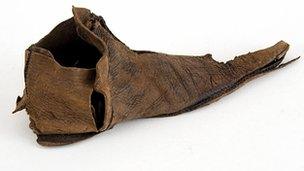Secrets of life on Newport's medieval ship revealed
- Published
In the summer of 2002, thousands flocked to the banks of the River Usk in Newport, to see a piece of history.
In the middle of a building site, the mud had been cleared to reveal the 500-year-old remains of a trading ship.
Built in 1447, it is the world's best preserved example of a 15th Century vessel. Nearly ten years after it was uncovered, archaeologists are still making new discoveries about life on board.
They hope that in the next decade the ship will be rebuilt and put on display in its own museum.
Charles Ferris, from the Friends of the Newport Ship group, remembers the excitement as news of the discovery spread.
"It was amazing, it was absolutely palpable. I often think the Newport ship floats on a sea of goodwill," he said.
"The Newport public did us proud and came out to support her in their thousands. People used to queue for two to three hours just to see her."
The timbers were uncovered during work to build the Riverfront Theatre and Arts Centre. After a campaign to ensure it was preserved, the ship was moved timber by timber to an industrial unit nearby.
Around 2,000 oak timbers have been preserved in chemically-treated water tanks.
'Tell you so much'
For almost 10 years, archaeologists have been carefully working through hundreds of boxes of artefacts that were also salvaged from the mud.
Toby Jones, curator of the Newport medieval ship project, said: "We have literally thousands of things like shoes, coins, animal bones, fish bones, nuts, seeds, pollen.
"It's all very interesting and can tell you so much about what life was like back in the medieval period."
But it would be wrong to assume that by now, all of the ship's secrets have been revealed. As the tenth anniversary of its discovery approaches in 2012, experts are still making new findings.
Mr Jones added: "A piece of rope was found during the excavation. It's incredibly well preserved.
"It's so well preserved we can tell its structure, how it's made and the material it was made from, its overall size and how strong it would've been and, therefore, what it was used for in the ship.
Suitable site
"We only dug this out of the mud two weeks ago. This is what routinely shows up. Really nice examples that we didn't even know we had."

Items found include a medieval shoe once considered the height of fashion
The industrial unit is more of a laboratory than a museum and so a study is now being carried out to find a suitable site, or building, to permanently display the ship.
The plan is to rebuild it, timber by timber, but space is an issue. When it was built, it would've been the length of three double-deckerbuses.
"Building the ship is actually going to take two to three years in itself," said Mr Jones.
"We're actually going to build the ship in the same order that they built the original ship in the medieval period. We're going to learn just as much in that phase of the project as we've learned so far.
"When you go to see the ship in a museum in five or six years, rebuilt, you're not going to need any imagination. It's going to look like a ship and it's going to blow you away."
- Published10 October 2011
- Published9 October 2010